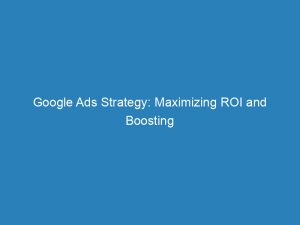Are you a small business owner looking to boost your online presence and drive more traffic to your website? Look no further than GoogleAds, one of the most powerful and effective advertising platforms available today.
But setting up a successful GoogleAds campaign requires careful planning and strategizing. You need to define your goals, identify your target audience, and optimize your bidding strategies to get the best results.
In this article, we will explore the different aspects of Google Ads strategy, from setting up your campaign to choosing the right bid strategy for your goals. Whether you’re a beginner or an experienced advertiser, this guide has you covered.
So, let’s dive in and discover how to make the most of GoogleAds!
Table of Contents
- google ads strategy
- Transition To More Durable Solutions For Similar Audiences
- Reaching Audiences With Google Ads Optimized Segment
- Smart Bidding Strategies For Conversion Optimization
- Maximize Conversions Within A Fixed Budget
- Manual Bid Strategies For Customized Control
- Improving Ad Position And Reach Through Bid Increase
- Targeting Different Visitor Segments With Bid Management
- Different Bid Strategies For Different Campaign Goals
google adsstrategy
The Google Ads strategy involves various components and options to optimize campaigns based on specific business goals and target audience. Campaign setup in Google Ads is dependent on these factors.
For instance, using “Google Ads optimized segment” allows reaching out to website visitors, app users, and other relevant audiences. Additionally, smart bidding strategies like Enhanced CPC, Target CPA, and Target ROAS can optimize bids for conversions.
The Maximize Conversions strategy aims to obtain the maximum number of conversions within a specified budget. Manual bid strategies are also available, with the option of raising bids to improve ad position and reach more customers.
Bid management can further target different visitor segments with varying durations, allowing for improved campaign performance. Different bid strategies can be employed for different campaign types, based on specific goals.
Smart Bidding is highly recommended for campaigns focused on conversions, as it considers auction-time signals for optimization. Overall, bid strategies and smart bidding play a crucial role in implementing an effective Google Ads strategy.Key Points:
- Google Ads strategy involves optimizing campaigns based on business goals and target audience
- “Google Ads optimized segment” reaches out to website visitors, app users, and relevant audiences
- Smart bidding strategies like Enhanced CPC, Target CPA, and Target ROAS optimize bids for conversions
- Maximize Conversions strategy aims to get maximum conversions within a budget
- Manual bid strategies allow raising bids for better ad position and reach
- Bid management targets different visitor segments with varying durations for improved performance
Sources
https://support.google.com/google-ads/answer/2472725?hl=en
https://support.google.com/google-ads/answer/2476691?hl=en
https://blog.hubspot.com/marketing/google-adwords-ppc
https://support.google.com/google-ads/answer/10560629?hl=en
Check this out:
💡 Pro Tips:
1. Implement remarketing campaigns to target website visitors and app users who have already shown interest in your business.
2. Use ad scheduling to display your ads at specific times when your target audience is most likely to be active and ready to engage.
3. Experiment with different ad formats, such as responsive search ads and image ads, to see which ones resonate best with your target audience.
4. Utilize audience targeting options, such as demographic targeting and affinity audiences, to narrow down your reach and focus on the most relevant potential customers.
5. Regularly monitor and analyze the performance of your campaigns to identify areas of improvement and optimize your Google Ads strategy for better results.
Transition To More Durable Solutions For Similar Audiences
In the ever-evolving world of digital advertising, it’s crucial to stay ahead of the curve and adapt to the changing landscape. One such change that businesses using Google Ads will need to take note of is the transition of similar audiences to more durable solutions, starting May 1, 2023.
Similar audiences have long been a valuable tool for businesses to reach potential customers who have similar characteristics to their existing audience. However, Google Ads is now phasing out this feature and encouraging businesses to explore more effective and reliable solutions.
The move towards more durable solutions is a strategic step by Google to ensure better targeting capabilities and improve the overall performance of advertising campaigns. While the specifics of these new solutions have not been fully revealed, it is expected that they will provide businesses with better audience insights and advanced targeting options.
This transition emphasizes the importance of keeping up with the latest developments in the advertising industry and adapting your strategies accordingly. By staying informed and exploring the new options that Google Ads will offer, businesses can continue to effectively reach their target audience and maximize their advertising efforts.
Reaching Audiences With Google Ads Optimized Segment
In order to reach a wider range of potential customers, it’s essential to utilize the various targeting options provided by Google Ads. One powerful tool that businesses can leverage is the Google Ads optimized segment.
The Google Ads optimized segment allows businesses to reach not only their website visitors but also their app users and other relevant audiences. This feature enables advertisers to create highly targeted campaigns and deliver customized messaging to specific groups of people.
By using the Google Ads optimized segment, businesses can ensure that their advertisements are seen by the right people at the right time. This level of precision targeting can significantly improve campaign performance and increase the likelihood of conversions.
Smart Bidding Strategies For Conversion Optimization
When it comes to optimizing bids for conversions, Google Ads offers a range of smart bidding strategies. These intelligent bidding strategies utilize machine learning and automated algorithms to optimize bids based on real-time data and campaign goals.
Some popular smart bidding strategies include Enhanced CPC, Target CPA, and Target ROAS. Enhanced CPC adjusts manual bids in order to maximize conversions within a given budget.
Target CPA sets bids to achieve a specific target cost per acquisition. Target ROAS aims to maximize conversion value by setting a specific return on ad spend target.
These smart bidding strategies take the guesswork out of bid management and allow businesses to focus on their overall campaign strategy. By leveraging the power of machine learning, advertisers can optimize their bids for conversions more effectively and achieve better results.
This post updated with new ad network performance data.
Maximize Conversions Within A Fixed Budget
For businesses looking to obtain the most conversions within a specific budget, the Maximize Conversions bidding strategy is an excellent choice. This bidding strategy automatically sets bids to achieve the maximum number of conversions possible within the allocated budget.
By utilizing the Maximize Conversions strategy, businesses can ensure that their ad spend is being utilized to its fullest potential. This strategy can be particularly beneficial for businesses with limited budgets, as it allows them to prioritize conversions and maximize the return on their advertising investment.
It’s important to note that while the Maximize Conversions strategy aims to obtain the most conversions, it does not guarantee a specific cost per conversion. Therefore, businesses should carefully monitor their campaign performance and adjust their strategies as needed to achieve their desired results.
Manual Bid Strategies For Customized Control
While smart bidding strategies offer automation and efficiency, some businesses may prefer to have more control over their bidding decisions. For those looking for a customized approach, Google Ads provides manual bid strategies.
Manual bid strategies allow businesses to set their own maximum cost-per-click (CPC) bids, giving them complete control over their campaign budgets. This approach is ideal for businesses that have specific bidding strategies in mind and want to fine-tune their bids for optimal performance.
It’s important to note that while manual bid strategies provide flexibility, they also require continuous monitoring and adjustments to stay competitive. Advertisers using manual bidding should regularly analyze their campaign data and make necessary bid adjustments to ensure they are effectively reaching their target audience.
Improving Ad Position And Reach Through Bid Increase
One of the key benefits of bidding on Google Ads is the ability to improve ad position and reach more customers through bid adjustments. By increasing bids, businesses can enhance their ad visibility and increase the likelihood of attracting clicks and conversions.
Raising bids can be particularly effective for campaigns that aim to maximize ad position and reach a larger audience. However, it’s important to balance bid increases with the budget and desired return on investment (ROI).
Careful monitoring and analysis of campaign performance is crucial to ensure that bid increases are yielding the desired results.
By making strategic bid adjustments, businesses can fine-tune their campaigns to reach a wider audience and improve their overall ad performance.
Targeting Different Visitor Segments With Bid Management
Every business has a unique audience, and Google Ads allows advertisers to target different visitor segments with customized bid management. By segmenting visitors based on specific characteristics or behaviors, businesses can better tailor their bidding strategies and campaigns to maximize results.
Bid management allows businesses to set different bids for different visitor segments, depending on their value and conversion potential. By identifying high-value segments and bidding more aggressively for them, businesses can improve their campaign performance and increase the likelihood of conversions.
It’s important to regularly review and analyze campaign data to identify visitor segments that are driving the most value. By constantly refining bid management strategies based on performance insights, businesses can optimize their Google Ads campaigns for maximum impact.
Different Bid Strategies For Different Campaign Goals
Not all campaigns have the same goals, and Google Ads recognizes this by offering different bid strategies to cater to various objectives. The choice of bid strategy should align with the specific goals of a campaign to maximize results.
For campaigns focused on conversions, smart bidding strategies are highly recommended. These strategies, such as Target CPA and Target ROAS, take into account auction-time signals and optimize bids accordingly to drive conversions.
On the other hand, bid strategies like Maximize Clicks are more suitable for campaigns with consistent budgets aimed at increasing website traffic. This strategy focuses on obtaining the most clicks within the allocated budget.
It’s important for businesses to clearly define their campaign goals and select the most appropriate bid strategy to achieve those goals. By aligning bid strategies with campaign objectives, businesses can optimize their Google Ads performance and achieve the desired results.
Native Ad Network • Buy Traffic • Advertising Platform for Marketers • Performance Marketing Tips












